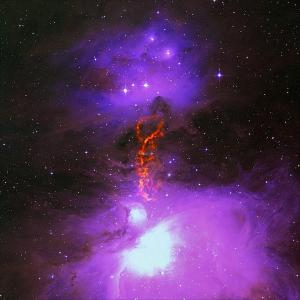Blog
Gravel Road
6 September 2014
We have a pretty good idea of how planets form around stars. We know that dust is formed from the remnants of supernovae, that protoplanetary disks of dust form around young stars, and that dust grains can clump together to form pebbles. We also know how larger planetoids can drive the formation of planets, and how planets can migrate from their point of origin to their stable orbits. But there are still gaps in our understanding.
 S. Schnee, et al.; B. Saxton, B. Kent (NRAO/AUI/NSF)
S. Schnee, et al.; B. Saxton, B. Kent (NRAO/AUI/NSF)For example, we aren’t entirely sure how we get from pebble-sized particles to planetoid-sized objects. It all has to do with the amount of drag objects experience while moving through the protoplanetary disk. Initially most of the dust grains are extremely tiny, less than a micrometer in size. Because they are so tiny, the amount of drag they experience from the surrounding gas is minimal. They are so tiny that they are almost gas-like in their behavior. For large clumps, on the order of hundreds of meters in diameter, the drag of surrounding gases is also relatively negligible. Their mass is large enough that over the 10 million year period of planetary formation, the gas doesn’t slow them down much. But in between there is a size that is big enough for drag to matter, but not massive enough to overcome that drag. This is on the scale of about a meter. When clumps reach this size, the drag of the surrounding gas would cause them to slow down rather quickly. As a result they would spiral into the star before they can grow much larger.
If this were true, then planets would be very rare. But we know planets are quite common, so there must be a mechanism that prevents planetary seeds from falling into the star. There have been some ideas, such as pressure waves in the planetary disk causing pebble-sized grains to clump into larger planetoids rather quickly, but this would require gravel-sized grains to form early on, which we aren’t sure could happen.
Now a new paper has found evidence of gravel-sized dust grains in the Orion Molecular Cloud.1 The team used radio telescope observations to determine the size of dust grains in the cloud. This technique is nothing new, but the team found filaments of dust grains that are a millimeter to a centimeter in size. This is much, much larger than typical dust grains observed. What’s particularly interesting about this discovery is that the filaments are in a region where stars will likely start forming in the next 100,000 to a million years. It is possible, then, that these large grains formed within the general cloud itself. If that’s the case, protoplanetary disks could have a ready-made source of large grains that could kickstart the formation of planetoids early on.
Although this is an exciting result, we should still be a bit cautious. The radio observations could be explained by things other than large dust grains (though that doesn’t seem likely), so we will need further observations to confirm the result. We also aren’t sure whether these grains actually formed in the molecular cloud, or if they are debris remnants from another process.
But it seems we’ve found a gravel road from dust to planets.
Schnee, Scott, et al. “Evidence for large grains in the star-forming filament OMC 2/3.” Monthly Notices of the Royal Astronomical Society 444.3 (2014): 2303-2312. ↩︎